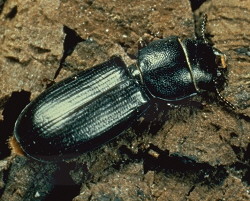Insect Pests of Stored Grain: Cadelle Beetle
ENTFACT-134: Insect Pests of Stored Grain: Cadelle Beetle | Download PDF
Tenebroides mauritanicus (Coleoptera: Tenebrionidae)
by Doug Johnson, Extension Entomologist
University of Kentucky College of Agriculture
Damage
Cadelles are primary feeders on a variety of grains, flour, and meal. They produce irregular holes in undamaged kernels and prefer the seed germ but will also eat endosperm. This beetle is commonly found in wooden bins. Both larvae and adults will bore into wood surfaces during their development cycle.
Description
Cadelles, the largest of the major stored grain beetles, are shiny dark to red brown and about 0.6 inch long. Their underside, antennae, and legs are red-brown. There is a distinct narrowing of the body between the prothorax and wing covers which gives the appearance of a distinct "waist." The outer corners of the prothorax project forward toward the head. Cadelle larvae, the worm-like immature stages, have creamy white elongate bodies with distinct black heads. There are two dark plates on the upper part of the segment just behind the head. A distinct plate with two horny points is present on the rear of the larvae. Full grown larvae are about 0.6 to one inch long.
Biology
Females may live more than a year and lay an average of 1,000 eggs each. The eggs are laid in batches of 10 to 60 in the grain or food materials. Both larvae and adults attack grain and typically go from kernel to kernel, feeding on the germ. There are usually four larval stages and one or two generations of the insect per year in temperate regions. Larval development may be as short as eight weeks under optimum conditions. The larvae often migrate from the source of the infestation to pupate in a hole within wood or other materials. Eggs and pupae are easily killed at 0 degrees F; however, larvae and adults can survive at 15 to 20 degrees F for several weeks.
Prevention is always the most economical and efficient method of controlling these pests. Once they are distributed within the grain mass, fumigation is the best method of relieving the problem. For specific insecticide recommendations for individual crops see:
- Corn, Field - Insecticides for Corn, ENT-16
- Popcorn - Insecticide Recommendations for Popcorn - ENT-62
- Sorghum - Insecticide Recommendations for Sorghum (Milo) - ENT-24
- Soybeans - Insecticide Recommendations for Soybeans - ENT-13
- Wheat - Insecticide Recommendations for Small Grains - ENT-47
These publications are available at local county extension offices in Kentucky.
Issued: 8/00
Revised: 7/09
CAUTION! Pesticide recommendations in this publication are registered for use in Kentucky, USA ONLY! The use of some products may not be legal in your state or country. Please check with your local county agent or regulatory official before using any pesticide mentioned in this publication.
Of course, ALWAYS READ AND FOLLOW LABEL DIRECTIONS FOR SAFE USE OF ANY PESTICIDE!
Photos: USDA Insect and Plant Disease Slide Set


